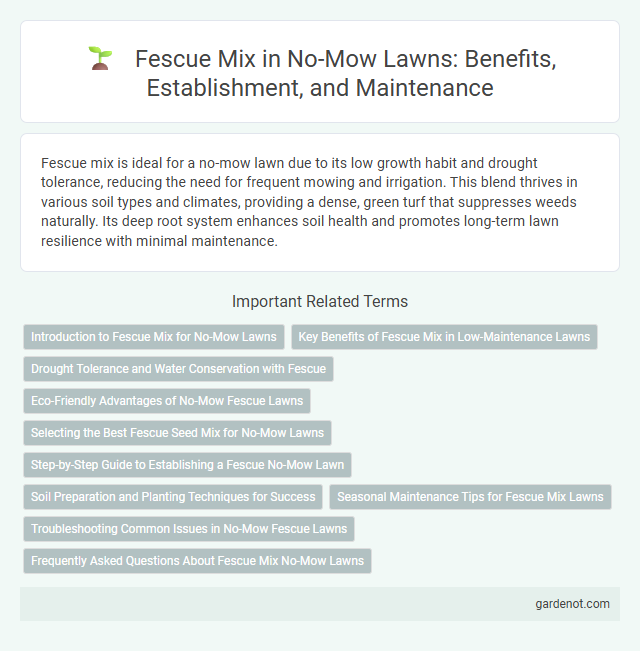Fescue mix is ideal for a no-mow lawn due to its low growth habit and drought tolerance, reducing the need for frequent mowing and irrigation. This blend thrives in various soil types and climates, providing a dense, green turf that suppresses weeds naturally. Its deep root system enhances soil health and promotes long-term lawn resilience with minimal maintenance.
Introduction to Fescue Mix for No-Mow Lawns
Fescue mix for no-mow lawns combines several cool-season grass varieties, including fine fescue species such as chewings, hard, and red fescue, designed to thrive with minimal maintenance. These grasses exhibit deep root systems and drought resistance, reducing the need for frequent mowing and watering while maintaining a soft, dense turf. Ideal for eco-friendly landscaping, fescue mix enhances soil health and supports biodiversity by providing natural habitats in low-maintenance lawn settings.
Key Benefits of Fescue Mix in Low-Maintenance Lawns
Fescue mix thrives in low-maintenance lawns due to its drought tolerance, deep root system, and shade adaptability, reducing the need for frequent watering and mowing. Its disease resistance and ability to remain green throughout seasonal changes ensure a durable, attractive lawn with minimal effort. Incorporating a fescue blend enhances soil health and sustainability, making it an ideal choice for eco-friendly no-mow landscapes.
Drought Tolerance and Water Conservation with Fescue
Fescue mix is highly valued for its exceptional drought tolerance, making it an ideal choice for no-mow lawns in water-scarce regions. Its deep root system enables efficient water absorption and retention, significantly reducing the need for frequent irrigation. Implementing a fescue-based lawn promotes water conservation while maintaining lush, green turf throughout dry seasons.
Eco-Friendly Advantages of No-Mow Fescue Lawns
No-mow Fescue lawns significantly reduce water consumption and eliminate the need for chemical fertilizers and pesticides, promoting a healthier ecosystem. The deep root systems of Fescue grasses enhance soil stability and increase carbon sequestration, contributing to climate change mitigation. These low-maintenance lawns support biodiversity by providing habitat for pollinators and beneficial insects, making them an eco-friendly alternative to traditional turfgrass.
Selecting the Best Fescue Seed Mix for No-Mow Lawns
Choosing the best fescue seed mix for no-mow lawns involves selecting varieties like fine fescue, tall fescue, and chewings fescue that tolerate low mowing and require minimal maintenance. High-quality blends emphasize drought resistance, shade tolerance, and disease resilience to ensure a durable, lush green appearance without frequent cutting. Proper seed selection promotes a dense, low-growing turf that thrives in diverse soil conditions, reducing water usage and mowing frequency.
Step-by-Step Guide to Establishing a Fescue No-Mow Lawn
Establishing a Fescue no-mow lawn begins with selecting a drought-tolerant, fine-bladed Fescue mix, including varieties like Tall Fescue and Fine Fescue known for low growth and deep roots. Prepare soil by aerating and applying a balanced fertilizer to promote healthy root development, followed by evenly spreading seeds at a rate of 5-8 pounds per 1,000 square feet. Keep the soil consistently moist for the first 3-4 weeks to ensure germination, then reduce watering frequency to encourage deep root growth that minimizes mowing needs.
Soil Preparation and Planting Techniques for Success
Fescue mix thrives in well-drained, fertile soils with a pH between 6.0 and 7.5, requiring thorough soil preparation including aeration and organic matter incorporation to enhance moisture retention and nutrient availability. Planting techniques emphasize seed-to-soil contact through shallow raking or rolling after broadcast seeding, coupled with consistent moisture maintenance during the critical germination period of 14 to 21 days. Proper site selection avoiding heavy shade ensures optimal growth, maximizing the durability and low-maintenance benefits of a no-mow fescue lawn.
Seasonal Maintenance Tips for Fescue Mix Lawns
Fescue mix lawns require consistent seasonal maintenance to thrive, including early spring overseeding and fertilization to promote density and repair winter damage. Regular mowing at a height of 3 to 4 inches supports strong root development and drought resistance throughout summer. Fall care should focus on aeration and applying a slow-release fertilizer to enhance nutrient absorption and prepare the lawn for winter dormancy.
Troubleshooting Common Issues in No-Mow Fescue Lawns
No-mow fescue lawns often face issues like patchy growth, which can result from inadequate sunlight or poor soil drainage. Addressing these problems involves improving aeration, adjusting mowing height to maintain leaf health, and overseeding bare spots with shade-tolerant fescue varieties. Regular soil testing and balanced fertilization ensure nutrient availability, reducing susceptibility to pests and diseases common in fescue blends.
Frequently Asked Questions About Fescue Mix No-Mow Lawns
Fescue mix no-mow lawns consist of fine fescue varieties like creeping red, chewings, and hard fescue, chosen for their low growth rates and drought tolerance. These grasses require minimal maintenance, typically needing mowing only once or twice per season, making them ideal for eco-friendly and water-efficient landscaping. The mix thrives in shaded to partially sunny areas, promoting dense turf that resists weeds while reducing lawn care time and resources.
Fescue mix Infographic

 gardenot.com
gardenot.com